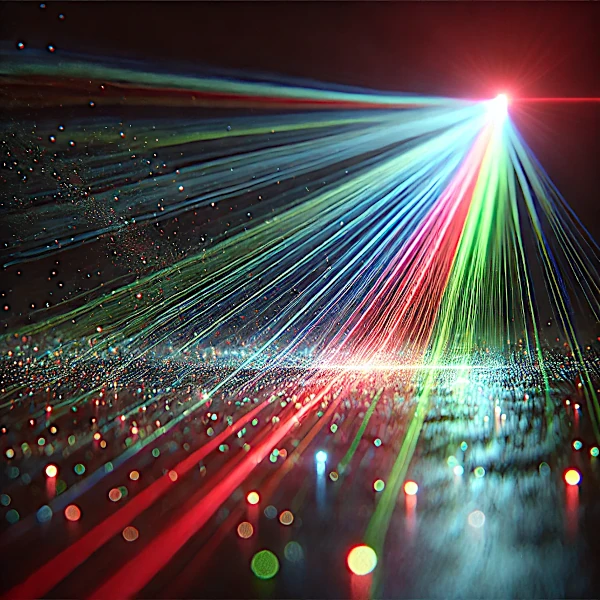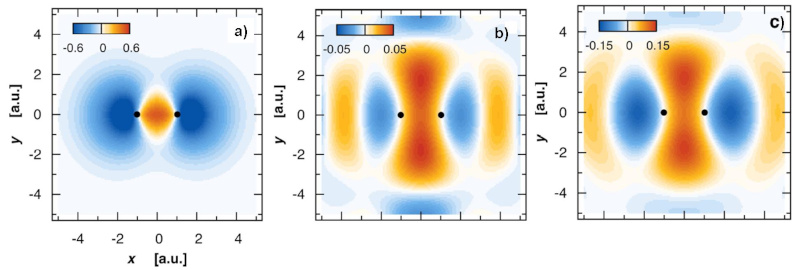
Image description: Laser light, described as early as 1917 by Albert Einstein (1879-1955), is blue, green, or red, i.e., composed of a single color. All other colors are subtle mixtures of colors. In 1960, the American physicist Theodore Maiman (1927-2007) achieved the first laser emission using a ruby crystal. Image source: astronoo.com
Natural or artificial light (daylight, incandescent lamp, LED, etc.) is composed of a superposition of all colors, i.e., a chaotic electromagnetic wave that propagates in all directions. It is not a wave with a regular and coherent length but rather a disorderly ripple on the surface of the water.
Laser light (Light Amplification Stimulated Emission of Radiation) is natural light stripped of all colors except one.
Although it is possible to manufacture lasers of several colors and going in several directions at the same time, the most common and efficient laser is the monochrome and unidirectional laser. Laser light is either blue, green, or red, i.e., composed of a single color (primary color). All other colors are mixtures of colors (secondary colors). Ex: a carrot absorbs blue, so its color is a subtle mixture of all colors except blue.
It is the duration of the optical cycle (period and frequency) that determines the color of the laser radiation. Laser light is ordered and can propagate in a straight line without deformation over very great distances provided it is amplified.
The image one can retain of laser light compared to natural light is that of a regiment marching in step as opposed to a crowd moving in a disorderly manner.
Stimulated light is an amplification obtained by the emission of two photons from the energy of a single photon. Thus, laser light will be stimulated in such a way as to be easily manipulable.
Thanks to mirrors, it can be propagated wherever one wants, as far as one wants, and the power can be increased as one wishes. Remarkable examples are laser guide stars used to adjust astronomical observations or the most powerful megajoule laser in the world, for testing nuclear fusion.
N.B.:
According to the equations of James Clerk Maxwell (1831-1879), light is a self-propagating transverse electromagnetic wave with electric and magnetic components where the electric and magnetic fields oscillate at right angles to each other and propagate perpendicularly to the direction in which they move indefinitely unless absorbed by intermediate matter. In other words, each type of field - electric and magnetic - generates the other to propagate the entire composite structure in empty space at the finite speed of light.
Laser light is not just used for decorating performance halls. The uses of lasers are numerous, ranging from very low-power diodes (0.000001 watt) found in optical readers to the megajoule laser (1015 watts) designed to experiment with controlled nuclear fusion.
Laser light has invaded our daily lives. It is found in supermarkets (barcode reading), in computing (DVD, Blu-ray reading, laser printer), in information transport (fiber optics), in precision measurements in physics (Earth/Moon distance, atom photography), in industry (laser rangefinder, radar, laser cutting, welding, engraving), in medicine (eye surgery, dermatology, laser scalpel), in defense (nuclear weapon simulation), in research (controlled plasma fusion), in astronomy (laser telemetry on satellites, adaptive optics with laser guide star).
We also produce invisible coherent lasers from microwaves (outside the visible spectrum), known as masers. These devices are widely used in various advanced fields such as interferometry, metrology, and atomic clocks. Masers play a crucial role in these applications due to their ability to generate extremely stable and precise electromagnetic waves, which are essential for high-precision measurements and advanced temporal applications.
To increase power, we also produce pulsed lasers.
These lasers emit light intermittently, allowing the observation of extremely fast physical phenomena. By emitting ultra-brief flashes of light, it is possible to capture ultra-brief images of rapidly moving objects. The femtosecond laser, for example, functions like a stroboscope, allowing photographic snapshots to be taken with an extremely short exposure time. For this, it is necessary to illuminate very intensely.
The advantage of pulsed lasers lies in their ability to concentrate light and increase its power over an extremely short duration. The shorter the flash duration, the higher the power.
In one attosecond (10-18 second), light travels the diameter of an atom, while in one second it travels the Earth/Moon distance. This ultra-short duration is adapted to the movements of molecules in matter and even to the movements of electrons in atoms. With the femtosecond laser, high peak powers (up to 100 joules per pulse) can be achieved, as in large petawatt systems. Various applications utilize all or parts of these unique properties of light (research, industry, biomedical field). From the attosecond laser, it is possible to photograph electron clouds around their atomic nuclei. By shaping both ultra-intense and ultra-short light pulses, one can penetrate to the heart of matter.

In this sequence of images, the characteristic structure of the nitrogen molecule N2 orbital can be seen. The first image is the calculated image, the second is the experimentally reconstructed image, and the third image is theoretically reconstructed.
Relationship between power and the duration of the flash of pulsed lasers.
E=Pt or Power = \(\frac{\text{Energy}}{\text{Time}}\)
If 1 joule is concentrated in 1 second, 1 Watt is obtained, 1 J in 1 ms yields 1 kilowatt, 1 J in 1 µs yields 1 megawatt, etc.
| Power and time of pulsed lasers (1 W=1 J/s) | |||
| 1 watt | 1 s or 100 s | led | |
| 1 kilowatt | ms or 10-3 s | toaster | |
| 1 megawatt | µs or 10-6 s | wind turbine | |
| 1 gigawatt | ns or 10-9 s | nuclear reactor | |
| 1 terawatt | ps or 10-12 s | cyclone | |
| 1 petawatt | fms or 10-15 s | gulf stream | |
| 1 exawatt | as or 10-18 s | sun light | |